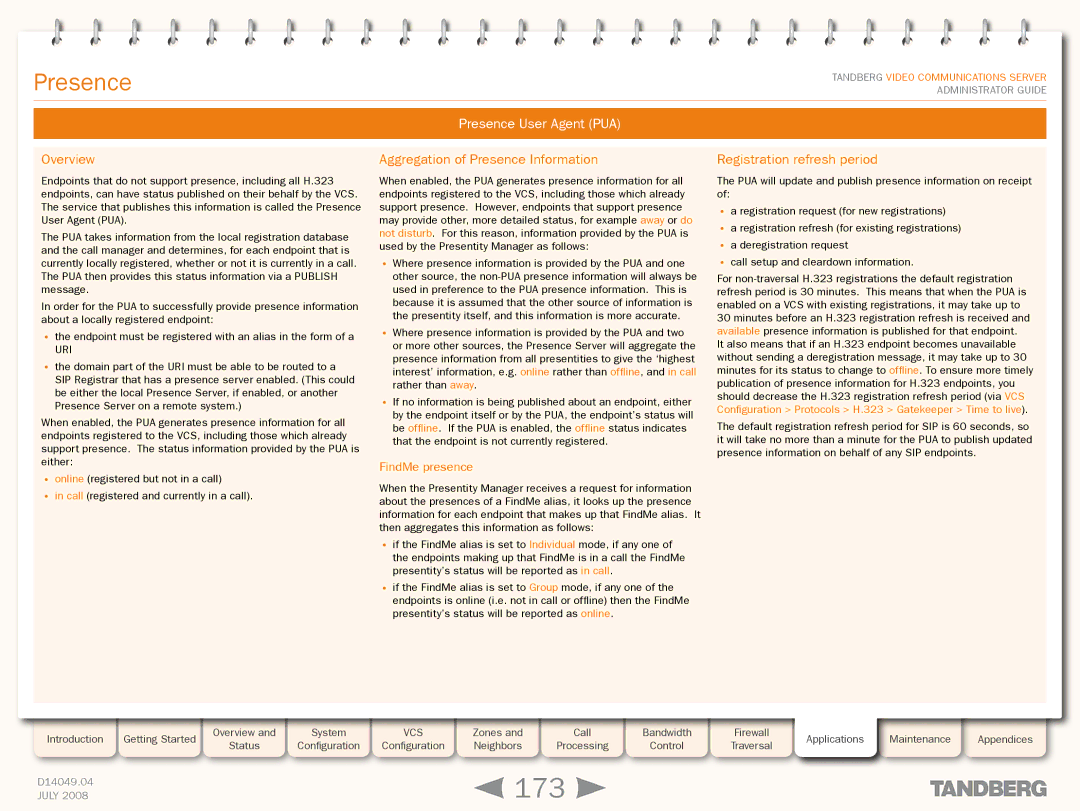
Grey Headline (continued)
Presence
TANDBERG VIDEO COMMUNICATIONS SERVER ADMINISTRATOR GUIDE
Presence User Agent (PUA)
Overview
Endpoints that do not support presence, including all H.323 endpoints, can have status published on their behalf by the VCS. The service that publishes this information is called the Presence User Agent (PUA).
The PUA takes information from the local registration database and the call manager and determines, for each endpoint that is currently locally registered, whether or not it is currently in a call. The PUA then provides this status information via a PUBLISH message.
In order for the PUA to successfully provide presence information about a locally registered endpoint:
•the endpoint must be registered with an alias in the form of a
URI
•the domain part of the URI must be able to be routed to a SIP Registrar that has a presence server enabled. (This could be either the local Presence Server, if enabled, or another
Presence Server on a remote system.)
When enabled, the PUA generates presence information for all endpoints registered to the VCS, including those which already support presence. The status information provided by the PUA is either:
•online (registered but not in a call)
•in call (registered and currently in a call).
Aggregation of Presence Information
When enabled, the PUA generates presence information for all endpoints registered to the VCS, including those which already support presence. However, endpoints that support presence may provide other, more detailed status, for example away or do not disturb. For this reason, information provided by the PUA is used by the Presentity Manager as follows:
•Where presence information is provided by the PUA and one other source, the
•Where presence information is provided by the PUA and two or more other sources, the Presence Server will aggregate the presence information from all presentities to give the ‘highest interest’ information, e.g. online rather than offline, and in call rather than away.
•If no information is being published about an endpoint, either by the endpoint itself or by the PUA, the endpoint’s status will be offline. If the PUA is enabled, the offline status indicates that the endpoint is not currently registered.
FindMe presence
When the Presentity Manager receives a request for information about the presences of a FindMe alias, it looks up the presence information for each endpoint that makes up that FindMe alias. It then aggregates this information as follows:
•if the FindMe alias is set to Individual mode, if any one of the endpoints making up that FindMe is in a call the FindMe presentity’s status will be reported as in call.
•if the FindMe alias is set to Group mode, if any one of the endpoints is online (i.e. not in call or offline) then the FindMe presentity’s status will be reported as online.
Registration refresh period
The PUA will update and publish presence information on receipt of:
•a registration request (for new registrations)
•a registration refresh (for existing registrations)
•a deregistration request
•call setup and cleardown information.
For
It also means that if an H.323 endpoint becomes unavailable without sending a deregistration message, it may take up to 30 minutes for its status to change to offline. To ensure more timely publication of presence information for H.323 endpoints, you should decrease the H.323 registration refresh period (via VCS Configuration > Protocols > H.323 > Gatekeeper > Time to live).
The default registration refresh period for SIP is 60 seconds, so it will take no more than a minute for the PUA to publish updated presence information on behalf of any SIP endpoints.
Introduction | Getting Started |
| Overview and |
| System |
| VCS |
| Zones and |
| Call |
| Bandwidth |
| Firewall |
| Applications |
| Maintenance |
| Appendices |
| Status |
| Configuration |
| Configuration |
| Neighbors |
| Processing |
| Control |
| Traversal |
|
|
| |||||
|
|
|
|
|
|
|
|
|
|
|
|
|
|
| |||||||
|
|
|
|
|
|
|
|
|
|
|
|
|
|
|
|
|
|
|
|
|
|
D14049.04 |
|
|
|
|
|
|
|
| 173 |
|
|
|
|
|
|
|
|
|
| ||
JULY 2008 |
|
|
|
|
|
|
|
|
|
|
|
|
|
|
|
|
|
| |||
